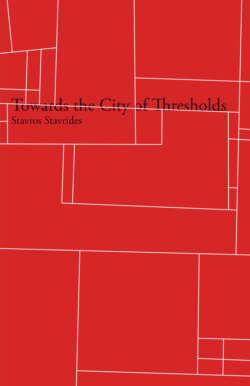Читать книгу Towards the City of Thresholds - Stavros Stavrides - Страница 11
На сайте Литреса книга снята с продажи.
Beyond borders
ОглавлениеMany assume the imposition of boundaries in human settlements is a natural phenomenon. Observing animals in the process of defining their territory, some suggest that a kind of natural will compels marking boundaries of an area where a single being or group reigns supreme. Territoriality appears as a natural need arising from the urge to survive while fighting against enemies or rivals. Thus, the demarcation of an area goes hand-in-hand with its description as a potential site of fighting. Although the act of marking out an area seems to be an attempt to ward off a fight it necessarily constitutes a declaration of war.
However, humans create settlements not only to define boundaries in order to secure a community that senses the hostility of the surrounding environment; boundaries are also crossings. An often-complicated set of ritual acts, symbolic gestures, and movements accompanies the crossing of boundaries. Invasion is only one among many other possible ways to cross the borders. So we could agree with Georg Simmel that man is not only “a bordering creature” but also the “creature who has no border” (Simmel 1997a, 69).
The creation of an enclosure, in Simmel’s words, contains the “possibility at any moment of stepping out of this limitation into freedom” (ibid.). If the bridge and the door materially exemplify this ability to separate and connect at the same time—since “the human being is the connecting creature who must always separate and cannot connect without separating” (ibid.)—then we must begin to understand bordering as an act that contains many possible meanings. It is not only the declaration of war on otherness but also the possibility of crossing the bridge towards otherness. It is not only hostility but also, perhaps, negotiation.
An exile, always feeling away from home, would probably describe an emphatically characteristic border consciousness. In the words of an activist who was forced to leave South Africa: “Indeed, the experiences and products of exile could be a dissolvent of border consciousness. It could be a way of reconnoitering, shifting and extending the limits” (Breytenbach 1993, 76).
An exile understands that borders possess the power to cut people off from the places that define them, their history, and their identity. But while away and not permitted to come back, the exile realizes that identity is not a totally circumscribed area marked by a permanently identified structure of characteristics.
Identities constructed in exile assimilate new experiences, discover new criteria, and check new targets. Identity thus becomes not an area defined by a boundary, but—to use a Bakhtinian term—it assumes a “chronotopic” quality (since it is being shaped inseparably by spatial and temporal indicators). Identity in exile is not only open to otherness, it is forced to face otherness.
Of course, the opposite experience is also possible. In a foreign land, an exile might attempt to seal off their identity. This attitude will freeze their identity in an imagined state of unpolluted innocence. Travelling mentally towards an imagined homeland, this exile is always absent, creating around themself boundaries even more rigid than those they have escaped or been expelled from. Fighting to preserve this small imaginary enclave of sameness from imaginary or real invasions, an exile of this mindset may thus strengthen the idea of borders as a site of clashing forces—forces that at the same time define and exclude.
What is it that the experience of an exile could reveal about border consciousness? Mainly that social identity is constructed through a process radically influenced by what could be called “the borderline of identity.” This borderline can be permeable or extremely controlled, can be a limit or a starting point, a place to inhabit or the entrance to a no man’s land extending between two opposing worlds that do not share common spaces, even when in contact.
The use of differing borders constructs the character of identity. A fixed and unambiguous identity is a closed identity with rigid borders. An open identity is one that that is enclosed in flexible borders offering meeting points with otherness. This kind of identity could, as we shall see, be described as possessing a threshold quality. Spatiotemporal thresholds would be the places where identities may negotiate encounters with otherness.
This line of thought would give new meaning to the words of David Harvey: “The relations between ‘self’ and ‘other’ from which a certain kind of cognition of social affairs emanates is always … a spatiotemporal construction” (Harvey 1996, 264). Indeed, not only because identities are understood as circumscribed areas defined by the quality and the specific place of their borders but also because concrete space and time relations make identities visible and materially effective. That is why the identity of persons or peoples can be forced to change via modulations of their spatiotemporal awareness.
